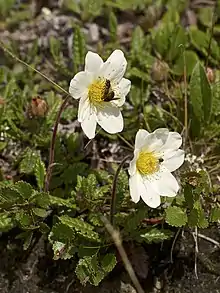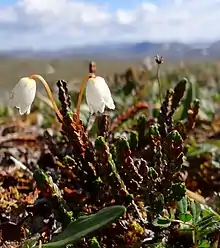Arctic vegetation
About 1,702 species of plants live on the Arctic tundra, including flowering plants, short shrubs, herbs, grasses, and mosses. These plants are adapted to short, cold growing seasons.[1] They have the ability to withstand extremely cold temperatures in the winter (winter hardiness), and grow and reproduce in summer conditions that are quite limiting.

As of 2005, arctic vegetation covered approximately 5×106 km2 (1.9×106 sq mi) of land.[2] The area of Arctic vegetation decreased by approximately 1.4×106 km2 (0.54×106 sq mi) from 1980 to 2000, with a corresponding increase in the boreal forest (taiga).[3] This decrease is linked to the warming of the Arctic due to climate change.[3][4]
Adaptations
Arctic plants have a number of adaptations to the compressed growing season and low temperatures:
- They initiate growth rapidly in the spring, and flower and set seed much sooner than plants that grow in warmer conditions.
- Their peak metabolic rate occurs at a much lower temperature than plants from farther south, but only peaks for a short growing season.[5]
- Some Arctic plants grow close to the ground as cushion plants, which keep the plants close to the warm soil and shield the tender central growing shoot.
- Arctic plants limit their height to be below the snow level. Plants that protrude above the snow are subject to strong winds, blowing snow, and being eaten by caribou, muskox, or ptarmigan.
- Arctic plants can survive very low temperatures because of high concentration of soluble carbohydrates, such as raffinose.[5]
- Reproduction by vegetative propagation is common.[5]
Mosses and lichens are common in the Arctic. These organisms have the ability to stop growth at any time and resume it promptly when conditions improve. They can even survive being covered by snow and ice for over a year.[6]
Effect of climate
Arctic vegetation is largely controlled by the mean temperature in July, the warmest month. Arctic vegetation occurs in the tundra climate, where trees cannot grow. Tundra climate has two boundaries: the snow line, where permanent year-round snow and ice are on the ground, and the tree line, where the climate becomes warm enough for trees to grow.[7] The snow line occurs when all monthly mean temperatures are below 0 °C (32 °F). The formula used for the tree line has changed over time: under the Köppen climate classification, the treeline occurs when the July temperature is 10 °C (50 °F).[7] Otto Nordenskjöld proposed that the warmest month must be at 9-0.1 T in Celsius, where T is the temperature of the coldest month. In 1947, Holdridge proposed computing the average of all months whose mean temperature are above zero: the treeline would occur when that average is 3 °C (37 °F).[8]

The July mean temperature is close to 0 °C (32 °F) in the coldest areas where Arctic vegetation can grow. At these temperatures, plants are at their metabolic limits, and small differences in the total amount of summer warmth make large difference in the amount of energy available for maintenance, growth and reproduction. As one goes for north to south, the size, horizontal cover, abundance, productivity and variety of plants increases:[10][9][11]
- Below 3 °C (37 °F), woody plants are absent.
- From 3 to 5 °C (37 to 41 °F), woody plants grow as prostrate dwarf shrubs. Examples include Dryas sp., and Salix arctica.
- From 5 to 7 °C (41 to 45 °F), woody plants increase in height to 15 cm (5.9 in). Examples include Arctous alpina and Cassiope tetragona.
- From 7 to 9 °C (45 to 48 °F), woody plants become erect dwarf shrubs, up to 40 cm (16 in) tall. Examples include Betula nana, Rhododendron tomentosum (Ledum decumbens), Vaccinium uliginosum.
- From 9 to 12 °C (48 to 54 °F), woody plants become low shrubs, up to 2 m (6 ft 7 in) tall. Examples include Betula glandulosa and Salix glauca.
- The treeline occurs when the July mean temperature is approximately 10 to 12 °C (50 to 54 °F).
Because small changes in temperature affect survival, growth, and reproduction of arctic plants, the effects of local microclimates can be significant. Plants low to the ground can create their own microclimate: when the air temperature away from the ground is −12 °C (10 °F), the temperature of dark moss can be 10 °C (50 °F).[12] Even if the local microclimate cannot maintain temperatures above 0 °C (32 °F), some arctic plants and flowers, such as Chamaenerion latifolium, can survive a frost with no damage.[12] Some plants start to grow under up to 100 cm (39 in) of snow cover.[12]
References
- Saville, DBO (1972). Arctic adaptations in plants. Research Branch, Canada Department of Agriculture. Monograph No. 6.
- Walker, Donald A; et al. (2005). "The circumpolar Arctic vegetation map". Journal of Vegetation Science. 16 (3): 267–282. doi:10.1111/j.1654-1103.2005.tb02365.x.
- Wang, Muyin; Overland, James (2004). "Detecting Arctic Climate Change Using Köppen Climate Classification". Climatic Change. 67: 43–62. doi:10.1007/s10584-004-4786-2. S2CID 153816797.
- Pearson, Richard G; et al. (2013). "Shifts in Arctic vegetation and associated feedbacks under climate change". Nature Climate Change. 3 (7): 673–677. Bibcode:2013NatCC...3..673P. doi:10.1038/nclimate1858.
- Billings, WD; Mooney, HA (1968). "The ecology of Arctic and Alpine plants". Biological Reviews. 43 (4): 481–529. doi:10.1111/j.1469-185X.1968.tb00968.x. S2CID 85714370.
- "Tundra – Plants – Adaptations". ThinkQuest.org. Archived from the original on May 1, 2007.
- McKnight, Tom L; Hess, Darrel (2000). Physical geography : a landscape appreciation. Upper Saddle River, New Jersey: Prentice Hall. p. 235. ISBN 9780130202635.
- Jones, Allan. "Biodiversity lectures and practicals". University of Dundee. Archived from the original on 2007-09-29.
- "Making of the Circumpolar Arctic Vegetation Map". Toolik-Arctic Geobotanical Atlas. University of Alaska, Fairbanks. Retrieved 2021-10-18.
- "Circumpolar Arctic Vegetation Map". Toolik-Arctic Geobotanical Atlas. University of Alaska, Fairbanks. Retrieved 2021-10-18.
- "Alaska Arctic Tundra Vegetation Map". Toolik-Arctic Geobotanical Atlas. University of Alaska, Fairbanks. Retrieved 2021-10-18.
- Bliss, L.C. (1960). "Adaptations of Arctic and Alpine plants to environmental conditions". Symposium Life Under Extreme Conditions: 85–172.